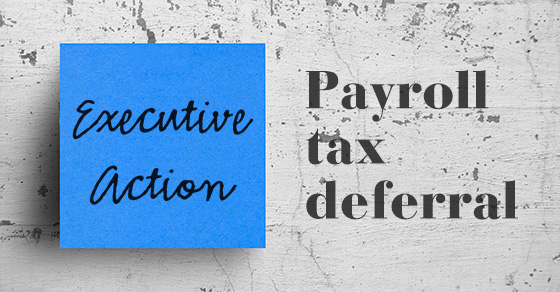Executive Order Update – Payroll Tax Deferral

How the Latest Executive Orders Might Affect Your Business
Also check our PPP Loan Forgiveness Update Below
As you may have heard, President Trump signed four executive orders. The orders provide relief on two areas that affect employers in addition to student loan deferrals and protection from evictions the forms of:
- Payroll tax deferral
- Unemployment aid expansion
Please note that these orders are still not yet set in stone.
Payroll Tax Deferral
The deferral concerns the employer’s portion of the payroll tax. To recap, as an employer, you are responsible for half of the Social Security tax (FICA) for your employees.
Briefly, the FICA tax is 12.4% – half paid by the employee (6.2%), and the other half by the employer, up to the annual wage base. Medicare tax (MEDI) works similarly, 2.9%, half (1.45%) paid by the employee and the other half paid by the employer. MEDI is not part of the executive order.
The executive order would allow employers to stop withholding the employee portion of FICA tax between September 1 and December 31, 2020, and delay, or defer payment of those taxes.
This employee payroll tax deferral acts like a tax cut but because it is actually a deferral, the taxes will still be due at a later date. Currently there is no word on what the process to pay those taxes back looks like, but there is speculation that employers would be responsible to collect those taxes and pay them. Or employees would just catch up on the deferred taxes when they file their 2020 tax return.
The deferral only applies to employees earning less than $104,000 annually ($4000 bi-weekly)
Depending on which way the political winds blow, there is a chance these deferred taxes could be eventually forgiven.
Despite a lot of detail on how the process will work, Treasury Secretary Steven Mnuchin said the payroll tax deferral would not be mandatory for employers to implement. And, employees can opt out of having their payroll taxes deferred.
Unemployment Extension
In addition to the payroll tax deferral for FICA, the President also issued an executive order modifying and extending $600 federal unemployment stipend that ended in July.
The order calls for the federal government to reinstate the extra benefit level of $400 as opposed to $600. However, the federal government would only pay 75%, or $300 out of the $400 unemployment benefits. States would be required to chip in the remaining $100.
There is speculation that many states would not be able to fund 25% of the benefit.
Based on the order, the unemployment aid would last either through December 6, 2020, or until funding runs out.
Nothing is Final
As with anything that has political ramifications, nothing is final with regards to these orders. There may be challenges in court, and its possible Congress steps in to negotiate a final package.
Stay tuned, we will keep you updated with any new information we receive.
PPP Forgiveness Update
This is a quick update on the PPP forgiveness process. After processing a client’s application (get more info), we noticed even though this client’s payroll far exceeded the loan amount to date, the PPP application only allowed forgiveness on 60%. So seemingly, the new 60% threshold was a blessing, turns out it makes things a little more difficult, but easy to remedy.
Here’s the Fix
Even though you may have expended all your PPP funds, you should continue to track your eligible payroll expenses (Gross wages, SUTA, ETT) through the 24 week period following your loan disbursement date. You may need a longer period of time to reach that 60% threshold.
IMPORTANT: Do not be in a hurry to go through the forgiveness process. Finish the 24 week period and use all your eligible payroll and non-payroll related expenses on your forgiveness application.
